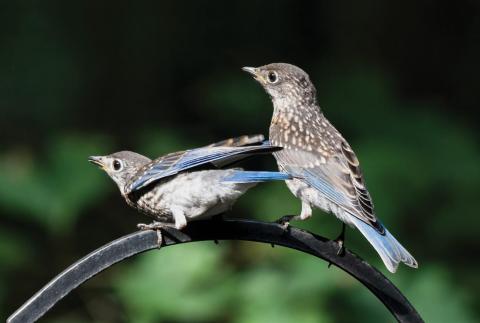Bluebirds of a Feather

September 27, 2023 -
If you walked around the campus of Carol Woods in the summer of 2023, you may have seen some birds that look
like this. These are Bluebird babies, two of 181 young Bluebirds that successfully fledged in 2023 under the
watch of the Carol Woods Nest Box Trail.
The Trail has a legacy dating back 25 years to when Audrey Booth and Sue Fletcher, former Carol Woods residents, bird enthusiasts, and environmentalists, decided to erect Bluebird houses around campus to encourage the breeding of Eastern Bluebirds. Along with other dedicated volunteers, they checked the houses regularly and reported the results—nest-building, eggs, hatch date, and successful fledging—to the Laboratory of Ornithology at Cornell. The scientists there study the status and trends of the reproduction of our nesting birds.
Now under the umbrella of the Carol Woods Bird Club, the Bluebird Trail has expanded to include Brown-Headed Nuthatch houses. Forty volunteers monitored 33 nest boxes this year— 23 Bluebird houses and 10 Brown-Headed Nuthatch houses. Some of the Nuthatch houses were apparently sublet to Carolina Chickadees and even one Carolina Wren family. The volunteers report observations of nesting behaviors to Kay Edgar, who then submits them online to Cornell.
Bluebirds can brood up to three times in one season. From the end of February until mid-August, we counted 246 Bluebird eggs. Of those eggs, 181 baby Bluebirds successfully left the nest (a process called fledging).
We reported 32 Brown-Headed Nuthatch eggs, and 17 baby Nuthatches fledged. Some of the Brown-Headed Nuthatch houses hosted Carolina Chickadees. We also counted 24 Carolina Chickadee eggs, and 19 baby Chickadees fledged. Unlike Bluebirds, Brown-Headed Nuthatches and Carolina Chickadees have only one brooding cycle per season.
This was a challenging year for our nest box birds, yet our birds persevered. In March we had unusually cold weather, just as some of the birds were laying their eggs. We ended the season in July and August with unseasonably high temperatures. And during the year we had construction taking place all around Apartment Building 1. Jen Schilkowski, head of Landscape and Grounds, rushed to the rescue twice to help relocate two active Bluebird houses in danger of being mowed down by heavy equipment.
This is more than just a scientific project—it’s an engagement with nature. Susannah Smith, who monitors a Bluebird house and a Brown-Headed Nuthatch house, commented that the project not only helps our feathered friends but also brings a sense of wellbeing to us two-legged animals. It gives our community pleasure when we see the flashing blue, hear an owl hoot, and wonder what the wrens’ conversation is all about.
The Nest Box Monitoring Season begins in February. The Bird Club provides orientation and training for new and returning volunteers.
– Kay Edgar
